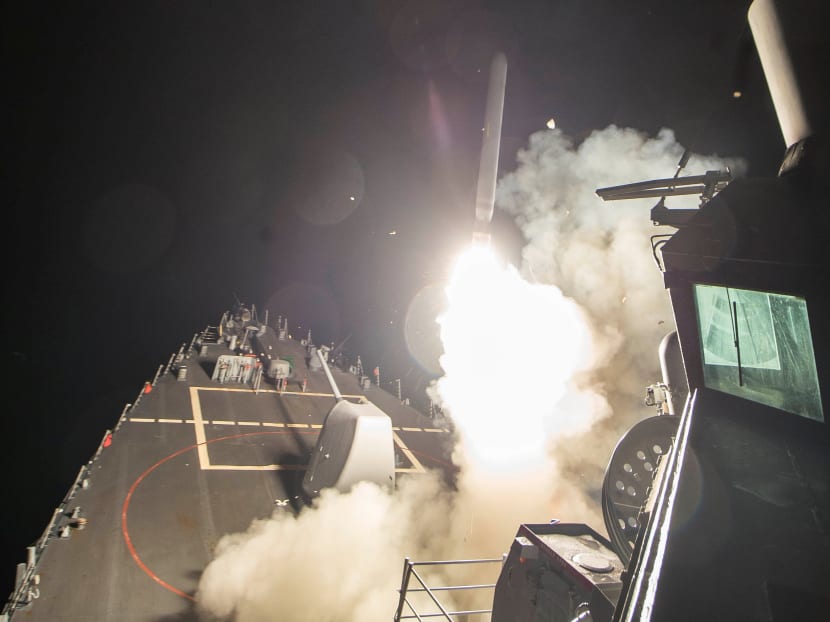News analysis: The Tomahawk missile - the weapon of choice for US presidents
SINGAPORE — When the United States launched a Tomahawk cruise missile attack on Syria on Friday (April 7) morning to retaliate against Damascus’s suspected use of chemical weapons against civilians earlier this week, President Donald Trump became the latest in a line of American presidents to use the precision-guided munition.

US Navy guided-missile destroyer USS Ross (DDG 71) fires a tomahawk land attack missile in Mediterranean Sea which Defense Department said was a part of cruise missile strike against Syria on April 7, 2017. Photo: Reuters
SINGAPORE — When the United States launched a Tomahawk cruise missile attack on Syria on Friday (April 7) morning to retaliate against Damascus’s suspected use of chemical weapons against civilians earlier this week, President Donald Trump became the latest in a line of American presidents to use the precision-guided munition.
Friday’s strike involved two US Navy ships firing 59 Tomahawk cruise missiles on the airbase where a plane allegedly took off to carry out a sarin gas attack in Syria’s Idlib province on Tuesday. The choice of using the Tomahawk comes as no surprise.
Since its first deployment during the 1991 Gulf War, the weapon has been deployed extensively in either one-off missions like last October’s strike on Houthi forces in Yemen or during the opening stages of a longer-drawn conflict such as the 2003 Iraq War. The Tomahawk’s attractiveness to US presidents ranging from Bill Clinton to Barack Obama lies primarily in the fact that it is not only a potent weapon in its right but also because it helps minimise casualties amongst American servicemen.
The “body bag” syndrome has plagued the American psyche following Washington’s withdrawal of its last forces from Vietnam in 1973 and has shaped the course of US military since then. Simply put, this phenomenon is the tendency for public opinion to turn against their government’s use of armed force in an overseas operations when the casualty toll mounts.
To the US public writ large, getting “our boys” killed in action against tinpot dictators in some far-flung land should be avoided.
The best example of the body bag syndrome being evoked was arguably during America’s humanitarian intervention in Somalia during the early 1990s. In October 1993, 18 US servicemen were killed during a botched operation in Somalia’s capital of Mogadishu.
During the incident that inspired the movie Black Hawk Down, Somalians also dragged the dead bodies of a few American troops on the streets and this was captured on television, prompting a strong public outcry back in the US. Unsurprisingly, President Clinton withdrew American forces from Somalia not long after the incident.
The Battle of Mogadishu would weigh heavily in the minds of Pentagon planners in the ensuing years, making Washington even more averse to incurring combat casualties. Witness the airpower-centric approach adopted during the Kosovo campaign of 1999 as well as the 2001 Afghan war.
While sending aircraft to strike targets would greatly minimise the number of US casualties — only the personnel manning the planes would come under enemy fire — losing even these few servicemen in combat might not be palatable to the American public
After all, the US Air Force (USAF) spends some US$6 million (S$8.4 million) a year training just one fighter pilot. Moreover, an American warplane destroyed means many millions of American taxpayers’ money going down the drain. To illustrate, the workhouse of the USAF — the F-16 Falcon fighter — costs some US$20 million while the corresponding figure for the F-22 Raptor stealth jet is a princely US$140 million.
The Tomahawk cruise missile offers a powerful yet cost-effective panacea to the problem of minimising American losses. With a range of over 1,600km, the weapon allows its launch platform to stay way out of harm’s way. In essence, the long range of the Tomahawk means that Washington could conduct operations with virtually zero casualties. What is more, the missile behaves almost like an unmanned stealth aircraft as its flight profile reduces the probability of detection by enemy sensors. At slightly more than US$1 million apiece, expending one Tomahawk is also relatively cheap compared to the cost incurred by a downed aircraft, not to mention the potentially explosive political ramifications if the aircrew were to be captured alive by the enemy.
It is perhaps telling that Washington chose not to deploy against the Assad regime even the ultra-sophisticated F-22 jets which it has utilised in the ongoing air campaign against the Islamic State of Iraq and Syria. The presence of modern Russian air-defence systems in Syria, like the S-400 that could reportedly detect stealth aircraft, could explain this non-deployment.
While US defence officials have said that Friday’s Tomahawk strike is a one-off and does not signal a shift in America’s Syria policy, it is anybody’s guess whether this would really be the case given the complexity not only of the Syrian conflict, but also because of the unpredictability of the Trump administration.
And were Washington to be drawn into broadening its role in Syria, do not discount more Tomahawk cruise missiles to be used as they provide, in the eyes of many a US military planner, a relatively cheap and potent solution to security problems without endangering the lives of precious American lives.






